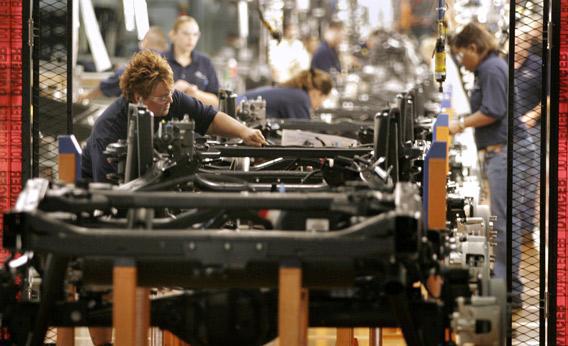American manufacturing unions are fighting a two-front war. Jobs in manufacturing are vanishing overseas as fast as they ever have, meaning that the ranks of workers—organized and unorganized—are thinning. Meanwhile, politicians have rarely seemed so protective of business and so unresponsive to labor. In February, Indiana became the nation’s 23rd right-to-work state, joining an anti-union America that spans the Southern part of the country and extends upward to Idaho and North Dakota.
Manufacturing unions have fallen from tremendous heights since the golden age of labor, which dawned in 1935 with the National Labor Relations Act and continued into the ‘50s and‘60s. During this period, collectives like the United Steel Workers and the United Auto Workers were forces to be reckoned with. The “Big Three” American automakers—Ford Motor Co., General Motors Co., and Chrysler—were in thrall to the UAW’s pattern bargaining tactics.
But right-to-work laws, outsourcing, and anti-union sentiment have massively weakened America’s unions, such that unionized workers made up only 11.8 percent of the workforce in 2011. In the manufacturing sector, that number dropped to 10.5 percent. What’s more, in the auto industry, the union-friendly Big Three are now competing for market shares with foreign companies like Honda, Nissan, and Toyota, none of which employ organized workers in their American factories. What is a manufacturing union to do?
Consider the case of the UAW, America’s most famous manufacturing union. Its first concern is jobs shipped overseas to China and Mexico. The union is using the collective bargaining process to “insource,” or recover domestic jobs, all while encouraging firms to invest in plants that lie within American borders. For instance, in 2011 the UAW negotiated with GM to reopen a plant in Spring Hill, Tenn., that had closed when the company went bankrupt. The reopening resulted in 1,171 jobs moving back into the United States from overseas. The same year, the union approached Ford about its policy of building small cars on foreign soil. It extracted an agreement from Ford to invest $16 billion in the manufacture of small cars in the United States, and the concession will create 12,000 jobs by 2015.
Organizing the nonunion competition is another UAW tactic for shoring up its power. The process is certainly not easy, as corporations fight incredibly hard to keep their workplaces union-free. But the most effective place to start is making sure that standards exist for fair union elections. Any group of workers has the right to vote for or against joining a union, but employers can clinch a no vote by implicitly or explicitly threatening workers’ jobs or benefits, inundating workers with anti-union materials, arranging mandatory anti-union meetings, threatening to close the facility, or screening job applicants to root out potential union supporters. In January 2011, the UAW drafted a set of rules designed to promote free elections. It pressed for firms to give unions equal time to talk to workers. (In the past, union representatives could only make house calls or try to stop employees as they drove out of plant parking lots.) It requested secret ballot elections to preserve workers’ privacy. And it asked employers not to promise higher wages or increased benefits to those who wished to remain unorganized. In terms of adopting the guidelines, progress has been mixed: Some companies prove more receptive than others, and the UAW can’t compel workplaces to accept its suggestions. But even articulating a few goals, said one union representative, is a significant first step.
The UAW is also attempting to engage more in state and national politics. Members are throwing their weight behind pro-labor candidates, especially President Barack Obama, whose loans to automakers during the financial collapse were estimated by one UAW representative to have saved 3 million jobs. Unions are phone banking, going door to door, forming political action committees, developing educational materials, organizing rallies, and creating worker-to-worker programs to spread the pro-labor—and mostly left-leaning— gospel. In September, the UAW sent 89 delegates to the Democratic National Convention in Charlotte, N.C. (even though it took place in a right-to-work state).
The UAW also advocates strongly for specific policies. In particular, it has lobbied Congress to pass Obama’s American Jobs Act, extend aid for the unemployed, refurbish urban transportation systems, update public school facilities and vacant apartment buildings, embrace progressive taxation, and provide funds to state and local governments.
A fourth and final strategy involves investing in green energy. The UAW has been vocal in its support of the 2017-2025 Corporate Average Fuel Economy (CAFE) standards, which reduce U.S. oil consumption by 12 billion barrels, slash greenhouse gas emissions by 6 million metric tons, and incentivize the purchase of electric and hybrid cars. This is not all environmental altruism: UAW President Bob King said the CAFE rules, finalized in August, “help propel the auto industry forward by giving American families long-term relief from volatile fuel prices.” He added, “Lowering the total cost of driving will make automobiles more affordable and expand the market for new vehicles.” One study by the BlueGreen Alliance projects that CAFE will create 570,000 jobs by 2030, “largely because consumers will spend less on fuel and more on other goods and services.” So it’s in the UAW’s interest to promote alternative energy sources—which it does not only through public statements like King’s, but through collaboration with companies that want to go green. For instance, the union recently partnered with the Thomas Built Bus company in High Point, N.C, a leader in producing hybrid buses and buses that run on natural gas.
The question, though, is not whether manufacturing unions are adjusting to new realities: It’s whether they’re doing it fast enough. The institutions aren’t stodgy, exactly—but the fact that none of the UAW representatives I reached out to felt comfortable providing on-the-record quotes for this story indicates their wariness—and perhaps even shows a kind of insular suspicion. Under siege, the UAW has hunkered down behind press releases and prepared statements. Will it ever be able to move out of its defensive posture?
